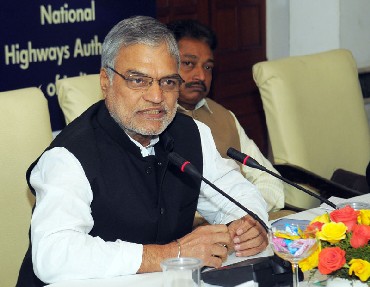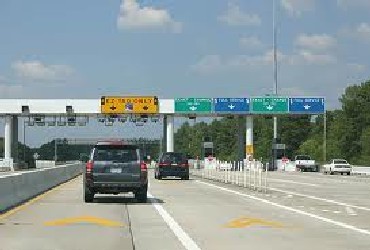Mihir Mishra in New Delhi
Early morning last Friday, in a post timed at 7.44 am, one Ramesh Jain wrote a rant against overloading.
It was the usual anguish many of us feel on seeing overloaded trucks on highways and toll plazas and the state officers' connivance in letting them go.
It could have been like any other post on a social networking site, triggering an echo among some of those on the friends list and that would have been that. Jain's rant, however, was posted on the Facebook wall - yes, it's there! - of the National Highways Authority of India (NHAI).
On the very next working day, there was a reply at 5.12 on Monday evening. "In this regard, instructions from the road secretary have been issued to principal secretaries (transport) and transport commissioners of all the states and union territories to strictly curb the practice of overloading," wrote Abdul Ali, general manager, NHAI.
...
Indian highways: What is the future?
Image: CP JoshiPhotographs: Courtesy: PIB
Before you shake your head disbelievingly at the prompt response, listen to this official of the ministry of road transport and highways, who refused to be named: "Our minister's focus is on transparency in project award and execution. He has also decided to put NHAI on Facebook to address complaints."
Giving the highways authority a slot on the information superhighway is not where it ends.
C P Joshi, who moved from the rural development ministry to take charge of the transport ministry in the Cabinet reshuffle on January 19, is living up to his long-standing reputation as being meticulous, thorough and transparent.
In the process, he is allowing room for comparisons - in the ministry and outside - with his predecessor Kamal Nath, generally considered a man of the world, who was comfortable in the global arena, as underlined in his earlier role as the trade minister.
...
Indian highways: What is the future?
The road transport and highways ministry is not known for breaking speed records. National highway projects of 5,101 km were awarded last financial year, which is about half of what could have been.
Under the new minister, though, the slow pace of the ministry is being attributed to Joshi's style of functioning, rather than any inefficiency in NHAI.
Joshi, it is said, does not push for clearances from committees. "Had the minister pushed for over 1,000 km of road projects from the Cabinet Committee on Infrastructure, NHAI would have awarded at least 6,000 km," said an official.
The Empowered Group of Ministers on highways recently scaled down the road project award target to 7,300 km for this financial year.
This works out to 20 km a day, though Joshi has not announced a target rate of construction.
...
Indian highways: What is the future?
Image: Kamal Nath, CP Joshi's predecessorNath had, soon after taking charge of the ministry: 20 km a day. He did manage to construct 13 km a day. T R Baalu, who was the minister before Nath, could manage no more than four.
Convinced the project awards should be about twice as much as the targeted construction, Nath was eyeing 12,000 km in annual awards.
There are those who say the new minister is realistic. "Unlike Nath, who announced a target to build roads at 20 km a day soon after he joined, the new minister believes in doing something first and then announcing targets," said an official.
Factoring in the awards spilled over from last year, NHAI hopes to award contracts for 100 projects this financial year, covering 11,151 km. On an average, NHAI would have to award eight projects every month.
...
Indian highways: What is the future?
In the early part of his tenure, Nath awarded 12-13 projects a month, but there was a lull of two and a half months after the Central Bureau of Investigation (CBI) in May 2010 visited NHAI in Delhi and arrested two senior officials as part of its probe into the award of the Nagpur-Betul project.
The award of contracts did resume later, but was down to a trickle.
Glasnost guy
Soon after Joshi took charge of the portfolio, he made it clear that he wanted the functioning of the ministry to be more open. Starting electronic bidding for NHAI's road projects was one such initiative.
"Our minister's focus is to bring in transparency in project award and execution," said a ministry official.
...
Indian highways: What is the future?
NHAI officials, understandably, fully appreciate Joshi's approach unlike Nath, Joshi leaves them to run the authority. "NHAI officials received phone calls from the ministry every day. This has stopped."
Nath, now at the helm of the urban development ministry, has a different view. "I used to monitor a lot of things in NHAI, like land acquisition, and the progress report on a daily basis to ensure that we were able to achieve the target of building 20 km a day," Nath said.
He points out that the CBI raid during his tenure was not the first of its kind. "In the case of NHAI, no files of the highways authority come to the ministry. The CBI raids during my tenure were not the first. There had been raids earlier, too, and they (CBI) should do that because it helps in curbing corruption. I, too, had forwarded many complaints to the investigating authority."
...
Indian highways: What is the future?
His own man, Nath did not brook much say by the Planning Commission in the functioning of the ministry.
At an event where the Commission's Deputy Chairman, Montek Singh Ahluwalia, was present, Nath termed the panel "armchair advisors" who would not let things happen.
He went on to say that Terminal 3 of the Delhi airport could only be built in time because the Planning Commission did not interfere.
It was widely believed that an issue paper, titled 'Sub-prime Highways?', prepared by Gajendra Haldea, advisor (infrastructure) in the Planning Commission, was the reason behind Nath's tirade. The paper said NHAI would go "bankrupt" in three years.
...
Indian highways: What is the future?
The rationale offered was that it would have an outgo of Rs 50,000 crore (Rs 500 billion) over the next three years, whereas the cess used to finance it - Rs 2 on each litre of diesel and petrol sold - might not exceed Rs 25,000 crore (Rs 250 billion).
So, it would have to take on a debt of Rs 25,000 crore (Rs 250 billion) in addition to the Rs 5,000 crore (Rs 50 billion) already on its books, pushing up the total burden to Rs 30,000 crore (Rs 300 billion).
Haldea also estimated that in the next three years NHAI would have to pay Rs 7,500 crore (Rs 75 billion) for ongoing construction contracts, Rs 9,500 crore (Rs 95 billion) on account of annuity payments, Rs 25,000 crore (Rs 250 billion) on viability gap funding, Rs 7,500 crore (Rs 75 billion) on land acquisition and Rs 500 crore (Rs 5 billion) against arbitration claims.
...
Indian highways: What is the future?
Regardless of the doomsday predictions, the Planning Commission is now driving road policies.
"With Nath leaving, representatives from the Planning Commission sit in meetings convened by the minister," say officials.
When contacted, Haldea, who attends these meetings, would only say: "I have no comments to offer."
Some see the Planning Commission's hand in the decisions taken by Joshi. One of these is to award fewer projects on the BOT (build, operate, transfer)-annuity basis. BOT-annuity is one of the two public-private partnership modes on which NHAI awards projects, the other is BOT-toll.
...
Indian highways: What is the future?
Photographs: Neeraj Rakwal
The former, which involves fixed periodic payments by the government, increases the burden of annuity payments on the government and reduces the risk of tolling for private operators.
This year's Union Budget, for the first time, has defined the total liability on the government because of BOT-annuity projects and pegged it at a whopping Rs 83,794 crore (Rs 837.94 billion) for highway construction.
This is more than three times the value of projects awarded under the annuity mode.
The Planning Commission is now developing a new Engineering Procurement Contract (EPC) model to replace the annuity model.
The contrast between the two ministers' methods is most stark when one looks at the early moves they made in the ministry: Nath went to Singapore; Joshi to Facebook.












article